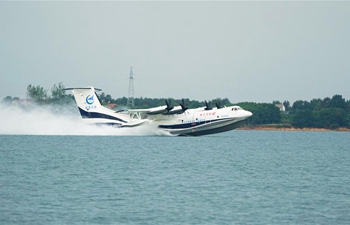WASHINGTON, Oct. 3 (Xinhua) -- American astronomers offered first compelling evidence for the existence of a moon orbiting a gas-giant planet 8,000 light-years away.
The study published on Wednesday in the journal Science Advances reported the detection of a candidate exomoon, or moons orbiting planets in other star systems. The exomoon, a satellite of planet Kepler 1625b, is large, comparable to the diameter of Neptune.
"This would be the first case of detecting a moon outside our solar system," said David Kipping, an assistant professor of astronomy at Columbia University, who, together with Alex Teachey at Columbia University, used NASA's Hubble Space Telescope and Kepler Space Telescope to reveal the object.
"If confirmed by follow-up Hubble observations, the finding could provide vital clues about the development of planetary systems and may cause experts to revisit theories of how moons form around planets," said Kipping.
The moon is estimated to be only 1.5 percent the mass of its companion planet, which itself estimated to be several times the mass of Jupiter.
This value is close to the mass-ratio between the Earth and its moon. But in the case of the Earth-Moon system, an early collision with a larger body is hypothesized to have blasted off material that later coalesced into a moon.
However, both Kepler 1625b and its satellite are gaseous rather than rocky, so such a collision may not lead to the condensation of a satellite.
The researchers measured the momentary dimming of starlight as 284 Kepler-discovered planets passed in front of their stars, called a transit and found Kepler 1625b had anomalies.
Then, they used Hubble to scrutinize the planet during its 19-hour-long transit across the face of the star and then detected a second and much smaller decrease in the star's brightness 3.5 hours later.
It was consistent with "a moon trailing the planet like a dog following its owner on a leash," according to Kipping.
"An extraterrestrial civilization watching the Earth and Moon transit the Sun would note similar anomalies in the timing of Earth's transit," said Kipping.
Exomoons are usually difficult to find because they are smaller than their companion planet and so their transit signal is weak and they also shift position with each transit because the moon is orbiting the planet.
Also, the ideal candidate planets hosting moons are in large orbits, with long and infrequent transit times. In this search, the Neptune-sized moon would have been among the easiest to first detect because of its large size.
The host planet and its moon lie within the solar mass star's habitable zone, but they're gaseous so "unsuitable for life as we know it," Kipping said.

















